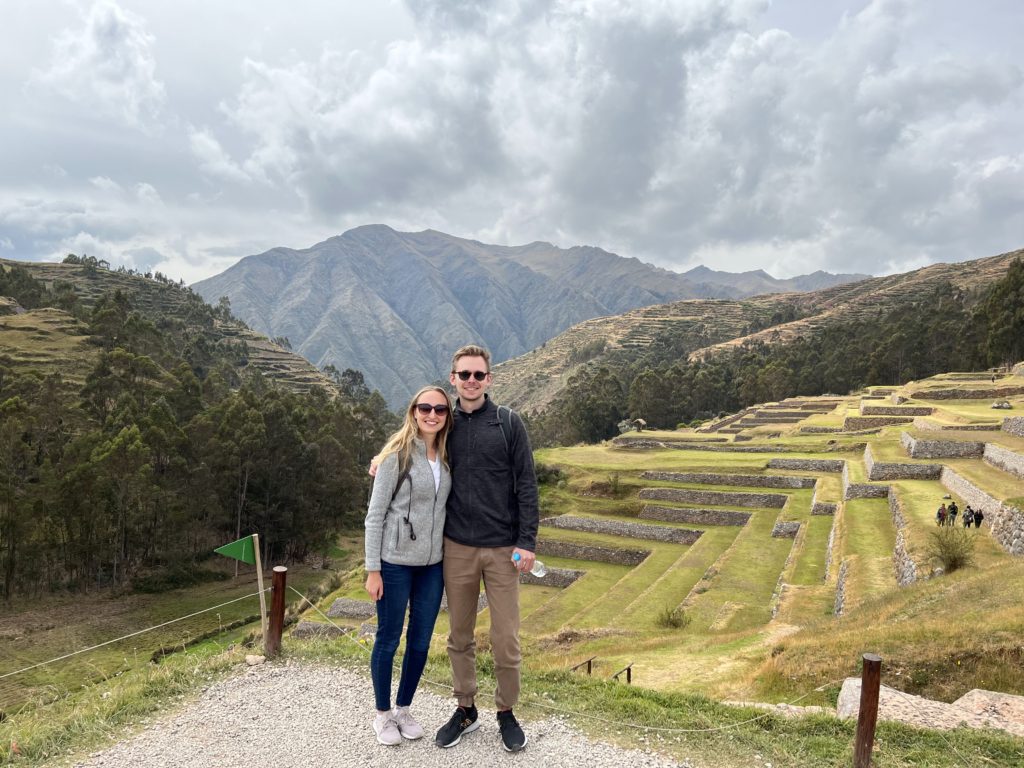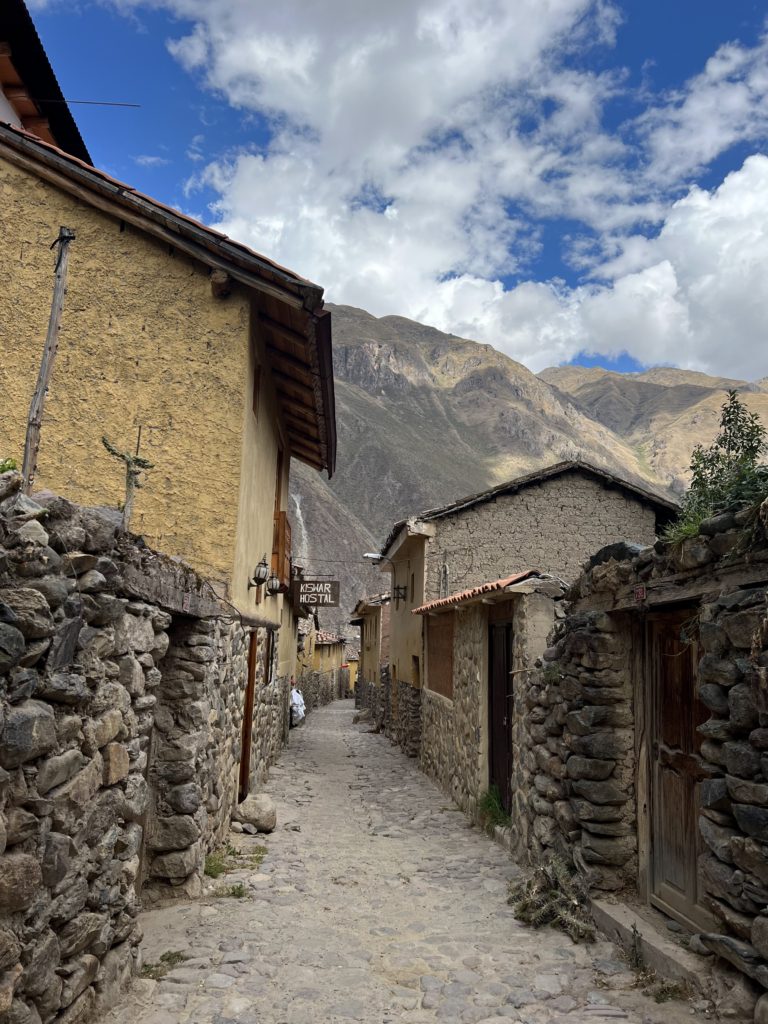Cusco
Cusco was definitely not the easiest city of our trip so far. Located at 11,200 feet, we came prepared with altitude sickness medication and dutifully started taking it the day before we landed at the Cusco airport. Even on medication, we felt the effects of the altitude pretty quickly. The walk to dinner was up a minor hill and we were winded by the time we got there! The first night resulted in John feeling pretty sick and neither of us getting much sleep – partially due to the fact that our room had no heating and it was 32 degrees outside. What a welcome!
After spending the entirety of our first full day in bed letting ourselves get acclimated, by day 2 we were starting to feel better. We went for a walk around the beautiful historic part of town. We even felt well enough to climb the hills around the city and visit the Christo Blanco, a large white statue of Jesus that looks over the city. We also took a free walking tour to learn more history about the town and ended up walking up even more hills. We complimented ourselves on how well we were adapting to the altitude, and were feeling on top of the world (kind of literally).
Unfortunately that feeling went away pretty quickly that night when John started to get more intense altitude sickness symptoms and we decided we needed to go to the hospital. The hospital staff quickly determined that he needed oxygen (we definitely weren’t the first patients to come in with this problem) and said we had to stay overnight. They set us up in a private room with two beds, and despite the fact that John had oxygen tubes up his nose we were grateful to be sleeping in a room with heating! All jokes aside – John is totally fine and the hospital staff were very kind and patient with our limited Spanish. Moral of the story is to take altitude sickness seriously and give yourself plenty of days to acclimate before doing anything too strenuous! (And double check if your hostel has heating – we now know that almost none of them do!) We took the rest of our time in Cusco easy – doctors orders – and spent our last day with a couple friends we had met in Lima.
Aside from the very upscale and touristy nature of the town, the most notable features are the remaining original Inca walls throughout the city that weren’t destroyed by the Spaniards. The walls are composed of stones that fit perfectly together like a puzzle, having essentially no gap between any side. The Incas would roll these giant stones down the mountains and chisel them to fit perfectly together – truly remarkable!




Sacred Valley Tour
In the morning, our guide Juan Carlos picked us up at our hostel in Cusco. We hired him to drive us to Ollantaytambo and take us to some Sacred Valley sites along the way. It was an awesome experience that we would recommend to anyone travelling in the area!
Our first stop was the archeological site in Chinchero. The site consists of a residential area, a temple, and farming terraces. The Spanish conquistadors’ M.O. was to knock down buildings of worship and build churches on top of them. That’s why a church now sits where the temple once was. We learned that the Incans developed terraced farming as a defense against heavy rain. During El Niño every four years or so heavy rains bring heavy floods which make flat areas unfarmable, so the Incas built terraced farms on hillsides for drainage. During Peru’s agrarian reform in the 1960’s, people wanted more land than the slice of terrace that would have been apportioned to them otherwise. So they started farming on flatter land where they had more space. With the assistance of technology like plows, bulldozers, etc, farming here was feasible even despite El Niño.


After the archeological site, we visited an alpaca textile workshop. A woman there showed us the process of spinning, dying, and weaving yarn. The process, even the materials they used for dye (like cochinil bugs), was very similar to Oaxaca. The woman showed us a bone she uses for weaving, and told us it’s from “a tourist who didn’t buy anything.” She followed us around their shop urging us to buy things (we didn’t) which was uncomfortable. We left a tip and hurried out.
Next we visited Moray, which is considered to be an Incan agricultural laboratory. Its exact purpose is subject to debate. Juan Carlos believes it was used to acclimate crops from lower elevations to thrive at high altitude by planting seeds on incrementally higher terraces. Others believe its purpose was not acclimatization but to simply learn about microclimates best suited to different crops. Either way, it’s a pretty impressive site and looks like something from a scifi movie.

After a lunch stop, we drove to Maras, home of the famous salt mines or “salineras.” All over the hillside are flat bed-sized pools filled with salty spring water. The spring emerges from inside the mountain, where it picks up salt and other minerals. The water zigzags through an impressive network of channels that reach every pool. Once full, the pools are evaporated so salt can be collected. Aside from culinary use, lots of the salt is sold to Japan where it’s used in facial scrubs.


After Maras, we drove the final stretch to Ollantaytambo. We headed for the ruins, which are situated at the junction of the Urubamba and Patakancha river valleys. In what’s left of the temple, giant stones are separated by thin vertical stone plates. Apparently, this was a technique used to protect the construction against earthquakes. If the large stones were in direct contact, then during an earthquake, excessive stress could cause the stones to crack. The thin stone plates act as sacrificial buffers to absorb the stress. The Spanish destroyed most of the temple, some of which now lies scattered all over the hill.


Ollantaytambo
Ollantaytambo is a small Incan town that clearly caters to tourists since it’s where you catch the train to get to Machu Picchu, but it remarkably also seems to have kept its culture. In the center of town is a large roundabout with dozens of restaurants advertising wood-fired pizza. But beyond the main square are very narrow cobblestone roads that lead to all of the houses, hostels, convenience stores, barber shops, etc. Our hostel was located a 5 minute walk up one of these roads in a family’s converted house. The family lives and works at the hostel, and the mom made us a delicious breakfast every morning. The family has a little dog and three cats as well, so we of course tried to adopt them as our own while we were there. One of the cats in particular (Susie) took an immediate liking to John, and every morning at breakfast would b-line directly to him and sit on his lap the whole meal.
We spent a fairly leisurely few days in the town, walking along the river and to a few different ruin sites. Up on the hill across the valley from the main Ollantaytambo ruins is an old food and grain storage building that you can hike up to for free. It was the perfect level of hiking (that the doctor said we were allowed to do at that elevation) and gave us a great view of the town. The storage building was built on this hill, somewhat far from the ancient town, because it was the highest, driest place the Incans could put it.
Another day we went to Naupa Iglesia, a huge cave between two giant rocks at the top of a hill that was used for ceremonies. It’s remote enough that we had to find a cab driver that was willing to sit there for an hour and wait for us to drive us back to town. We split the cab with two girls that were staying at our hostel which made it worth it (plus one was from Spain so could negotiate fluently with the cab driver, extra benefit). The place is known for having very strong spiritual energy, which the girls we were with were overwhelmed by and said was very powerful. Neither of us tend to “feel the energy” at places, but it was a beautiful location and we enjoyed hiking up to it!





The Food
Two common dishes in Cusco are alpaca and cuy (aka Guinea pig). We took the opportunity to try them both ourselves. The alpaca steak was tasty and we really enjoyed it! The Guinea pig was not bad, but the thought of it was definitely hard to get past. We learned Peruvians only eat cuy on special occasions, like birthdays or celebrations. If we didn’t think of them as pets I’m sure we would enjoy it more! We also ate quite a bit of fish with quinoa, it seemed to be on every restaurant’s menu and was always very tasty.
The last notable meal we had was a “special Hawaiian” wood-fired pizza in Ollantaytambo (it was impossible to be in that town without having at least one pizza). It was a normal Hawaiian pizza but with condensed milk drizzled over the top. It was very sweet but surprisingly good! Just don’t tell Italy, they’ll probably never let us back in.



Next stop – Machu Picchu!!
Christine & John